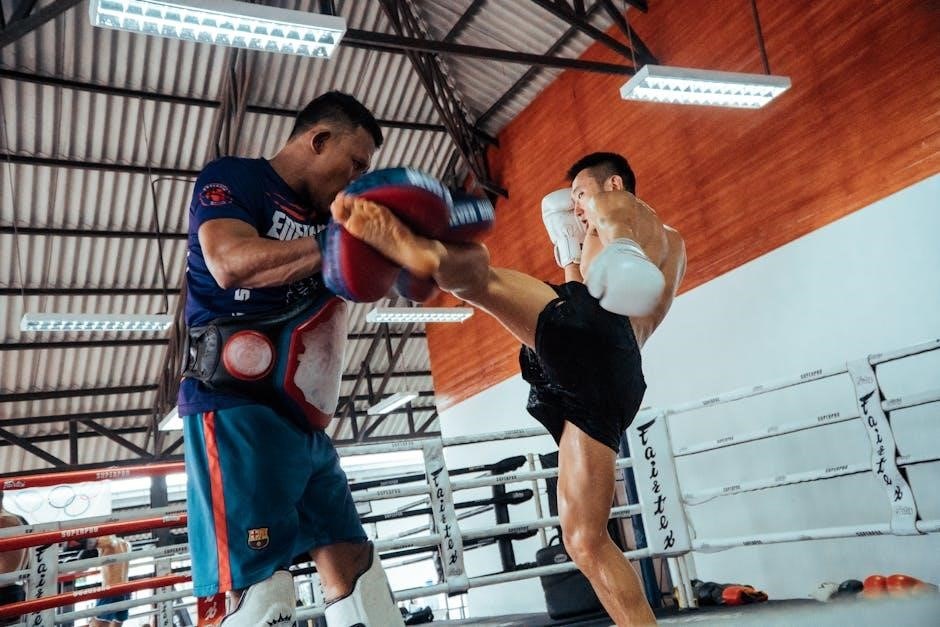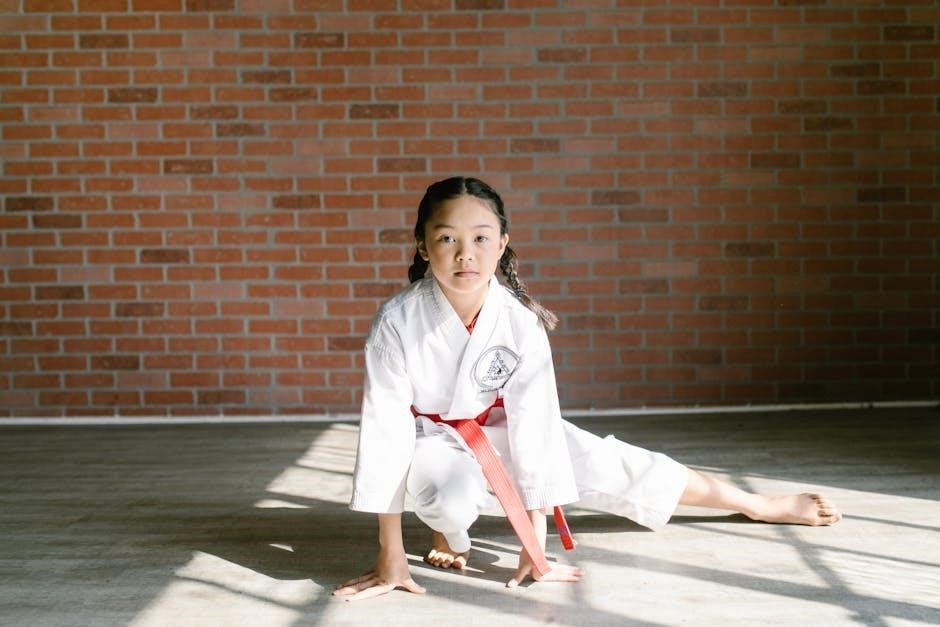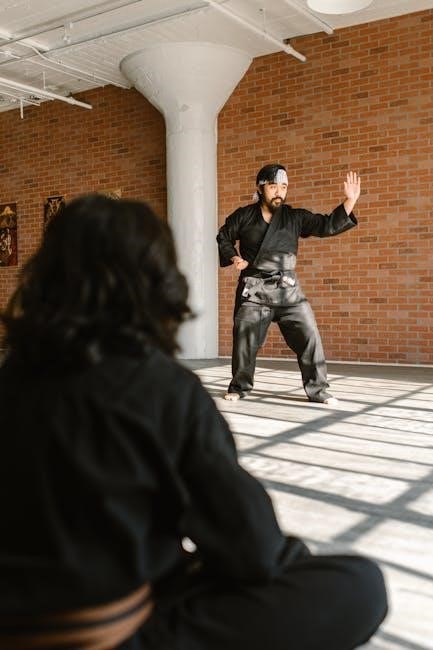kickboxing combos pdf
Kickboxing combinations are sequences of strikes and kicks that enhance offensive fluidity. Mastering these flows improves timing‚ power‚ and overall combat efficiency. Essential for both fitness and fighting‚ they blend punches‚ kicks‚ knees‚ and elbows‚ creating dynamic attacks. Proper technique and practice are crucial for executing combinations effectively and safely.
What Are Kickboxing Combinations?
Kickboxing combinations are pre-planned sequences of strikes‚ kicks‚ knees‚ and elbows executed in a fluid‚ continuous manner. They are designed to flow seamlessly‚ targeting multiple areas of an opponent’s body to maximize offensive effectiveness. Combinations can vary in length and complexity‚ from simple two-strike sequences to intricate multi-technique flows. They are essential for both competitive fighters and fitness enthusiasts‚ as they improve timing‚ coordination‚ and overall physical conditioning. By integrating punches‚ kicks‚ and defensive maneuvers‚ kickboxing combinations provide a holistic approach to offensive and defensive training‚ making them a cornerstone of kickboxing practice.
Importance of Mastering Combinations in Kickboxing
Mastery of kickboxing combinations is vital for enhancing offensive and defensive skills. It improves timing‚ coordination‚ and overall physical fitness. By practicing combinations‚ fighters develop muscle memory‚ enabling faster and more precise execution during a match. Combinations also boost confidence‚ allowing practitioners to adapt to various combat scenarios. They are essential for both competitive athletes and fitness enthusiasts‚ as they provide a structured approach to improving technique and stamina. Incorporating combinations into training routines ensures well-rounded skill development‚ making them indispensable in kickboxing.

Basic Kickboxing Combinations
Mastering fundamental combinations builds a strong foundation. Start with simple sequences like jab-cross-hook or reverse hook kick-round kick. These combos enhance technique and fluidity‚ essential for progress.
Jab‚ Cross‚ Hook Combination
The jab-cross-hook combination is a cornerstone in kickboxing‚ emphasizing precision and power. Begin with a jab to create distance‚ followed by a powerful cross to the head. Transition smoothly into a hook‚ targeting the sides or temples. This sequence improves hand-eye coordination and offensive flow. Proper form is essential‚ with each strike flowing seamlessly into the next. Practice this combo in shadow boxing or with a partner to build muscle memory. Over time‚ it becomes a natural response‚ enhancing overall combat effectiveness and preparing for more complex techniques.
Double Jab‚ Cross‚ Hook
The double jab‚ cross‚ hook combination is a powerful and versatile sequence. Start with two quick jabs to create distance and disrupt your opponent’s defense. Immediately follow with a strong cross to the head‚ generating maximum power. Finish with a hook to the body or head‚ aiming for vulnerable areas. This combo enhances offensive flow and targets multiple angles. Practice it with focus on fluid transitions and precise aim. Chambering your fists between strikes ensures quick delivery and maintains defensive readiness. Over time‚ this combination becomes a reliable tool in various fighting scenarios‚ improving both speed and accuracy.
Reverse Hook Kick‚ Round Kick
The reverse hook kick and round kick combination is a dynamic and advanced sequence. Begin by chambering your kicking leg‚ then execute a reverse hook kick‚ targeting your opponent’s head or body. Immediately follow with a powerful round kick‚ aiming for the same or different target areas. This combo emphasizes balance‚ coordination‚ and explosive power. The reverse hook kick sets up the round kick perfectly‚ creating a devastating flow. Practice this combination with focus on proper footwork and timing to maximize its effectiveness. It’s a staple in advanced kickboxing training‚ designed to overwhelm opponents with precision and speed. Mastering this sequence enhances both offensive and defensive capabilities;

Intermediate Kickboxing Combinations
Intermediate combinations expand on basics‚ adding complexity and variety. They integrate punches‚ hooks‚ elbows‚ and kicks seamlessly‚ improving timing and fluidity. Essential for developing advanced fighting skills.
Jab‚ Cross‚ Hook‚ Downward Elbow
This combination starts with a quick jab to create distance and gauge your opponent. Follow with a powerful cross to the head or body‚ generating maximum force. Transition smoothly into a hook to target the sides or head‚ maintaining balance. Finish with a downward elbow to inflict damage at close range. This sequence enhances offensive variety‚ combining punches and elbows for devastating impact. Practice timing and fluidity to execute it seamlessly. It’s effective in both competitive and fitness training‚ improving coordination and striking precision. Mastery of this combo requires focus on proper form and controlled power to ensure safety and effectiveness during drills or sparring.
Double Jab‚ Cross‚ Left Hook‚ Right Hook
Begin with a double jab to establish rhythm and create openings. Follow with a strong cross to deliver maximum power. Transition into a left hook to target the head or body‚ maintaining balance. Finish with a right hook to exploit defensive gaps. This combination emphasizes fluid transitions and precision‚ making it versatile for various scenarios. It’s ideal for intermediate practitioners‚ blending speed and power effectively. Regular practice enhances coordination and offensive versatility. Focus on proper footwork and hand positioning to maximize impact and maintain defensive integrity. This combo is highly effective in both competitive and fitness training‚ improving overall striking efficiency and adaptability in dynamic situations.
Cross‚ Hook‚ Elbow
Start with a powerful cross to create distance and generate momentum. Immediately follow with a hook to target the head or body‚ ensuring proper rotation and chambering. Transition seamlessly into a sharp elbow strike‚ aiming for close-range impact. This combination excels in close-quarters combat‚ blending striking versatility with fluid movement. Focus on maintaining balance and recovering quickly after the elbow to avoid counterattacks. Practice this combo to improve hand-eye coordination and offensive adaptability. It’s effective for intermediate to advanced practitioners‚ enhancing both power and precision. Regular drills will refine timing and overall execution‚ making it a reliable tool in various fighting scenarios and fitness training routines.

Advanced Kickboxing Combinations
Advanced combinations merge complex hand and foot techniques‚ requiring precise timing and fluid transitions. These sequences challenge experienced practitioners‚ enhancing their offensive arsenal and combat effectiveness.
Long Combinations: Joining Basic Combos
Long combinations involve seamlessly linking multiple basic techniques to create extended sequences. By integrating punches‚ kicks‚ and knees‚ fighters develop advanced offensive flows. These combos require precise timing‚ coordination‚ and stamina. Practitioners start by mastering shorter sequences‚ then gradually combine them into longer‚ more complex patterns. For example‚ a basic jab-cross-hook can transition into a roundhouse kick or knee strike. Conditioning and focus are essential to maintain power and accuracy throughout the combination. Drills such as shadow boxing and partner exercises help refine these extended sequences‚ enhancing both technique and endurance for real-world application in matches or self-defense scenarios.
Advanced Footwork and Timing in Combinations
Advanced footwork and timing are critical for executing complex kickboxing combinations effectively. Techniques like bobbing‚ weaving‚ and shuffling enable fighters to evade counters while setting up strikes. Proper timing ensures punches‚ kicks‚ and knees land with precision and power. Mastery of these elements allows for seamless transitions between strikes‚ creating fluid and unpredictable offense. For instance‚ a well-timed feint can open defenses‚ leading into a powerful combination. Footwork drills‚ such as ladder exercises and agility training‚ enhance coordination and balance‚ while shadow boxing helps refine timing. These skills elevate a fighter’s ability to control the pace of a match and deliver devastating combinations with accuracy and confidence.
Incorporating Knees and Elbows into Combinations
Incorporating knees and elbows into kickboxing combinations adds diversity and power to attacks. These strikes are particularly effective in close-range situations‚ allowing fighters to target vulnerable areas. A well-timed knee strike can disrupt an opponent’s rhythm‚ while an elbow can deliver a sharp‚ precise blow. Combining these with punches and kicks creates unpredictable offense. For example‚ a jab-cross-hook combination can seamlessly transition into a knee or elbow strike‚ catching the opponent off guard. Proper technique and control are essential to execute these strikes safely and effectively. Drills like pad work and clinch practice help refine the integration of knees and elbows into fluid‚ dynamic combinations‚ enhancing overall combat efficiency and versatility.


Training Methods for Kickboxing Combinations
Effective training involves shadow boxing‚ partner drills‚ and circuit training. Shadow boxing enhances technique‚ while partner drills refine timing and precision. Circuit training boosts endurance and mastery of combinations‚ ensuring fluid execution in real scenarios.
Shadow Boxing Drills
Shadow boxing is a fundamental drill for mastering kickboxing combinations. It involves practicing techniques in front of a mirror‚ focusing on form‚ balance‚ and fluid transitions between strikes. Start with basic combinations like jab‚ cross‚ hook‚ gradually incorporating kicks and defensive moves. Time yourself to build endurance‚ aiming for 3-5 minute rounds. Mirror work helps identify flaws‚ ensuring precise execution. Mix up tempos to simulate real fights‚ alternating between slow‚ controlled movements and explosive bursts. This drill sharpens technique‚ improves coordination‚ and mental focus‚ making it essential for all skill levels. Consistency in shadow boxing accelerates mastery of complex combinations.
Partner Drills for Combination Practice
Partner drills are essential for refining kickboxing combinations‚ offering real-time feedback and resistance. Focus on precision and timing by practicing strikes like jab‚ cross‚ hook while a partner holds pads or mitts. Alternate roles to ensure both offense and defense are honed. Incorporate defensive moves‚ such as slips and blocks‚ into the flow. Use Thai pads for kicking drills‚ allowing partners to absorb and counter strikes safely. Communication is key; clarify combinations and intensity beforehand. Rotate through various techniques‚ from basic punches to advanced knee and elbow strikes. This interactive method enhances adaptability‚ reaction time‚ and overall combat readiness‚ making it a cornerstone of combination mastery.
Circuit Training for Combination Mastery
Circuit training is a dynamic way to enhance combination skills‚ combining multiple stations that target different techniques. Each station focuses on specific combos‚ such as jab-cross-hook or round kick-elbow‚ performed in timed intervals. Trainees rotate through stations‚ maintaining intensity and proper form. This method boosts cardiovascular endurance‚ speed‚ and muscular endurance while refining technique. Incorporate equipment like heavy bags‚ Thai pads‚ or focus mitts for varied resistance. Time rounds (e.g.‚ 3 minutes) with short breaks (e.g.‚ 30 seconds) mimic fight conditions. Safety is paramount; ensure proper warm-ups‚ hydration‚ and equipment. Circuit training’s versatility makes it ideal for all skill levels‚ from beginners to advanced fighters‚ promoting well-rounded development and combination mastery.

Safety Tips for Practicing Kickboxing Combinations
Always wear proper gear‚ including mouthguards‚ gloves‚ and shin guards. Warm up and cool down to prevent injuries. Train with a qualified instructor for safe technique.
Proper Equipment and Gear
Using the right equipment is essential for safe and effective kickboxing training. A mouthguard protects teeth and gums‚ while 16-ounce gloves cushion hands and reduce impact. Shin guards and headgear are crucial for sparring sessions to prevent injuries. Hand wraps provide wrist support and minimize hand fatigue. A good pair of kickboxing shorts or training pants allows for mobility‚ and a jump rope is handy for warm-ups. Proper footwear‚ such as martial arts shoes‚ offers stability during drills. Investing in quality gear ensures safety‚ comfort‚ and optimal performance during combination practice.
Warm-Up and Cool-Down Routines
A proper warm-up prepares the body for kickboxing training‚ reducing injury risk. Start with light cardio like jogging or jumping rope for 5-10 minutes. Dynamic stretching‚ such as leg swings and arm circles‚ enhances flexibility. Shadow boxing with light movements eases into technique practice. After training‚ cool down with static stretches targeting major muscle groups—hamstrings‚ quads‚ and shoulders. Deep breathing exercises help lower heart rate and relax muscles. A thorough cool-down prevents soreness and promotes recovery. Incorporating these routines ensures a safe and effective workout‚ making them essential for mastering kickboxing combinations.

Kickboxing Combinations for Fitness
Kickboxing combinations enhance cardiovascular fitness and burn calories. Techniques like double jab‚ cross‚ two knees boost endurance‚ while jab‚ cross‚ jab‚ elbow improves coordination and strength‚ making workouts dynamic.
Double Jab‚ Cross‚ Two Knees
The double jab‚ cross‚ two knees combination is a dynamic sequence that enhances cardiovascular fitness and striking precision. Begin with a quick double jab to create distance and set up your opponent. Follow with a powerful cross to target the head or body. Transition smoothly into two rapid knees‚ aiming for the midsection or thighs. This combo improves coordination‚ balance‚ and endurance. It also engages the core and legs‚ making it a full-body workout. Practice this sequence with proper form to maximize its effectiveness and safety. Incorporate it into high-intensity interval training for a challenging and rewarding fitness routine.
Jab‚ Cross‚ Jab‚ Elbow
The jab‚ cross‚ jab‚ elbow combination is a versatile and effective sequence for fitness and combat training. It begins with a quick jab to gauge distance‚ followed by a powerful cross to engage the target. Another jab creates an opening‚ and a sharp elbow strike finishes the combination. This flow enhances hand-eye coordination‚ timing‚ and overall striking technique. It also works multiple muscle groups‚ improving cardiovascular endurance and muscular strength. Practicing this combo with focus pads or a heavy bag helps refine technique and boosts stamina. Incorporate it into circuit training for a dynamic and challenging workout that simulates real fight scenarios.

Cross‚ Hook‚ Elbow‚ Front Kick
The cross‚ hook‚ elbow‚ front kick combo is an advanced sequence that combines striking and kicking. Start with a powerful cross to create distance‚ followed by a hook to target the head or body. Transition into an elbow strike for close-range precision‚ then finish with a front kick to maintain distance. This combination enhances coordination‚ power‚ and versatility. It also engages multiple muscle groups‚ improving endurance and agility. Incorporate this combo into circuit training or partner drills to simulate real fight scenarios. Proper form and timing are essential to maximize effectiveness and safety‚ making it a valuable addition to any kickboxing fitness or combat training routine.

Mastering kickboxing combinations requires consistent practice and dedication. They enhance fitness‚ improve combat skills‚ and make training engaging. Effective combinations are key to kickboxing success.
Final Thoughts on Mastering Kickboxing Combinations
Mastering kickboxing combinations is a journey requiring patience‚ dedication‚ and consistent practice. By blending punches‚ kicks‚ knees‚ and elbows‚ fighters enhance their offensive capabilities and overall fitness. Effective combinations demand proper technique‚ timing‚ and footwork‚ which can be refined through drills like shadow boxing‚ partner exercises‚ and circuit training. Safety is paramount‚ emphasizing the use of proper gear and warm-ups. As practitioners progress‚ they can incorporate advanced techniques‚ such as long combinations and adding strikes like knees and elbows‚ to diversify their arsenal. The key to success lies in persistent training and adapting strategies to individual strengths and objectives.
Leave a Reply